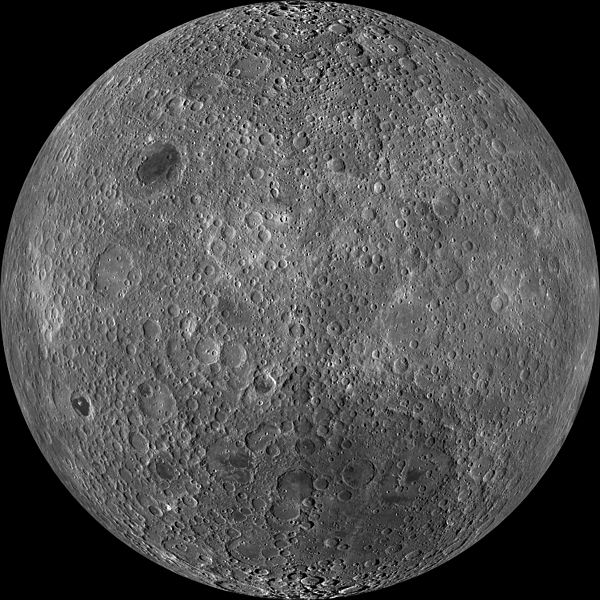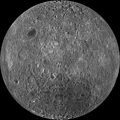فاىل:Moon Farside LRO.jpg

اي پيشأدئنˇ واويراز: ۶۰۰ × ۶۰۰ پيکسل. کیفیتهای دیگر: ۲۴۰ × ۲۴۰ پيکسل | ۴۸۰ × ۴۸۰ پيکسل | ۷۶۸ × ۷۶۸ پيکسل | ۱٬۰۲۴ × ۱٬۰۲۴ پيکسل | ۲٬۰۴۸ × ۲٬۰۴۸ پيکسل | ۱۸٬۰۰۰ × ۱۸٬۰۰۰ پيکسل.
أصلˇ فاىل (۱۸٬۰۰۰ × ۱۸٬۰۰۰ پیکسل، فاىلˇ واويراز: ۸۵٫۳۴ مگابایت، نوع MIME فاىل: image/jpeg)
فاىلˇ تاريخ
تاريخ/زمتؤنˇ سر کيليک بکۊنين تا اۊ تاريخ/زمتˇ نۊسخه' بىنين.
| تاريخ/زمت | کلˇ أنگۊشتي | أبعاد | کارگير | نظر | |
|---|---|---|---|---|---|
| ألؤنˇ نۊسخه | ۱۹ مارس ۲۰۱۴، ساعت ۲۳:۴۷ |  | ۱۸٬۰۰۰ در ۱۸٬۰۰۰ (۸۵٫۳۴ مگابایت) | Huntster | High resolution mosaic. |
| ۹ آوريل ۲۰۱۱، ساعت ۰۴:۱۲ |  | ۱٬۶۰۰ در ۱٬۶۰۰ (۱٫۴۴ مگابایت) | Bubba73 | {{Information |Description ={{en|1=Far side of the Moon, by NASA's Lunar Recon. Orbiter}} |Source =http://apod.nasa.gov/apod/image/1104/farside_lro1600.jpg |Author =NASA - LRO |Date =2011? |Permission = |other_versions = } |
فاىله کارأىتن
اي ولگ اي تاتاىئه خال بدأ دأنه:
فاىلˇ سراسري کارأىتن
اي ويکئن اي فاىله کارأىته دأنن:
- af.wikipedia.org مئن کارأىتن
- az.wikipedia.org مئن کارأىتن
- be.wikipedia.org مئن کارأىتن
- bjn.wikipedia.org مئن کارأىتن
- bn.wikipedia.org مئن کارأىتن
- bs.wikipedia.org مئن کارأىتن
- ca.wikipedia.org مئن کارأىتن
- cs.wikipedia.org مئن کارأىتن
- de.wikipedia.org مئن کارأىتن
- en.wikipedia.org مئن کارأىتن
- en.wikibooks.org مئن کارأىتن
- en.wikiversity.org مئن کارأىتن
- Solar System, technical/Moon
- User:Marshallsumter/Radiation astronomy2/Visuals
- Draft:Original research/Planets
- User:Marshallsumter/Radiation astronomy2/Visuals/Quiz
- User:Marshallsumter/Rocks/Rocky objects/Astronomy
- User:Marshallsumter/Radiation astronomy/Courses/Principles/Hourly 2
- User:Marshallsumter/Radiation astronomy/Courses/Principles/Midterm quiz
- User:Marshallsumter/Radiation astronomy/Courses/Principles/Final quiz
- Titan/Quiz
- User:Marshallsumter/Rocks/Rocky objects
- Draft:Enceladus/Quiz
- Moon/Quiz
- Stars/Sun/Heliology/Quiz
- Earth/Quiz
- Stars/Reds/Quiz
- Draft:Dione/Quiz
- User:Marshallsumter/Radiation astronomy2/Scattered disks/Quiz
- User:Marshallsumter/Radiation astronomy1/Kuiper belts/Quiz
- Liquids/Liquid objects/Moon
- User:Marshallsumter/Radiation astronomy/Craters
- es.wikipedia.org مئن کارأىتن
- et.wikipedia.org مئن کارأىتن
نمایش استفادههای سراسری از این پرونده.


